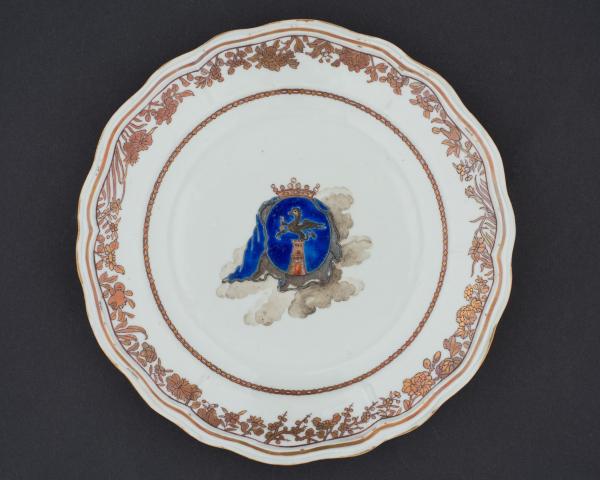Plate with the Arms of the Gyllenborg Family
Material(s): Porcelain
Origin(s): China around 1755
From all the ceramics and porcelain wares found in the Trade Gallery in ACM, these Armorial porcelain plates caught my attention. Although small in size, the Gyllenborg coat of arms were painted with such attentiveness, capturing the intricate designs of the arms and borders. The elaborate border contrasts against the somewhat simple family crest yet the gold from the gilding accentuates and complements the vivid deep blue colour of the crest. Thus, the highly detailed painting emanates an aureate element to the plate.
The gilt border uses vegetal forms such as flowers and leaves which come in many variations or perhaps different species native to Sweden. This border encircles an enamelled centre which features a family’s coat of arms. The crest features a golden crown resting atop a vivid deep blue oval suggesting nobility. Within the oval lies a miniature turret with a dark, winged creature posing on top of it. The creature has spikes on its back and claws arching outwards. Enveloping the blue oval, a dark greyish border along with some blue on the left are draped around it. Also, smoky greyish clouds are illustrated surrounding the crest’s bottom and left. Although it may be perceived that these clouds were part of the Gyllenborg’s crest, there was a funny and memorable story behind them. The clouds were an artistic mistake – things get lost in translation. So the story goes that the drawing of the Gyllenborg crest were damaged while being transported to China, and the “clouds” seen were not part of the drawing. The crest was smeared while being transported and the Chinese artist dutifully copied the details of the crest including the damage and thus, capturing and preserving the mistake for hundreds of years to come.
The floral inspired design of the gilt border can be seen in the form or shape of the plate whereby the edges of the plate is curved in an inconsistent yet symmetrical manner. The edges bend and curves in a specific pattern to create and ornate, attention to detail aesthetic. The gilded stylised floral decorations are reminiscence of the Rococo or Late Baroque style which modelled after nature along with the abundance of curves. As the plates were made for a noble family, the usage of gilding emphasises on their wealth and social status as the presence of gold gives off the impression of richness. In my opinion, the gilding is mainly found on the rim and outer edge of the plates as when food is served, the food itself covers the middle portion of the plate but the outer edge remains untouched. Hence, going back to my previous point, the first thing the diner sees is the gilding and thus is reminded of the family’s social status.


What are the meanings of those flowers and grasses?
Have you come across the Gyllenborg coat of arms? What are the differences between the original coat of arms and this version?
Interesting as here too like the Peranakan piece, color indicates social status. Not just motifs such as the coat of arms.
Is this part of a larger dinner set that was ordered? Was it only royalty and the aristocracy who could afford to do this? What about merchants?
Where are your 4 different sources?
There is no meaning or symbolism for the flowers or grasses but it was probably added to the plate’s design as a characteristic of the Rococo period that featured nature and fluidity in their work.
I was not able to find the original Gyllenborg coat of arms but the main difference that I have discovered from sources was that the grey clouds were not supposed to exist in the original.
Yes, this plate was a part of larger dinner set that came with saucers, deep dishes and service plates that all bore the Gyllenborg crest with the mistake on it. This porcelain dinner service was part of the Chinese export porcelain which was originally catered towards the aristocracy as they were regarded as objects of rarity and luxury. But eventually, international trade expanded and Chinese export porcelain became more widely available, allowing anyone, regardless of social class to collect them. However, not all Chinese export porcelain are considered the same. The Gyllenborg collection features polychrome enamels that allowed for the creation of complex and accurate decorations which was was conducive to painting intricate armorial crests that were one of a kind. Armorial procelain are regarded as “private trade” porcelain as they were custom made, unique and ordered in bulk. Hence it is more likely that these type of porcelain could only be afforded by people of great importance such as royalty and aristocracy.
“Armorial ‘Mistake’ Plate.” http://Www.roots.sg. Accessed November 08, 2018. https://roots.sg/learn/collections/listing/1248105.
Bailey, Gauvin Alexander. Baroque and Rococo. London: Phaidon, 2012.
Munger, Jeffrey, and Alice Cooney Frelinghuysen. “East and West: Chinese Export Porcelain.” The Met’s Heilbrunn Timeline of Art History. October 2003. Accessed November 09, 2018. https://www.metmuseum.org/toah/hd/ewpor/hd_ewpor.htm.
Nilsson, Jan-Erik. “China and Sweden: Treasured Memories.” Chinese Porcelain in Swedish Collections. Accessed November 08, 2018. http://www.gotheborg.com/exhibition/exhibit_62-150.shtml.